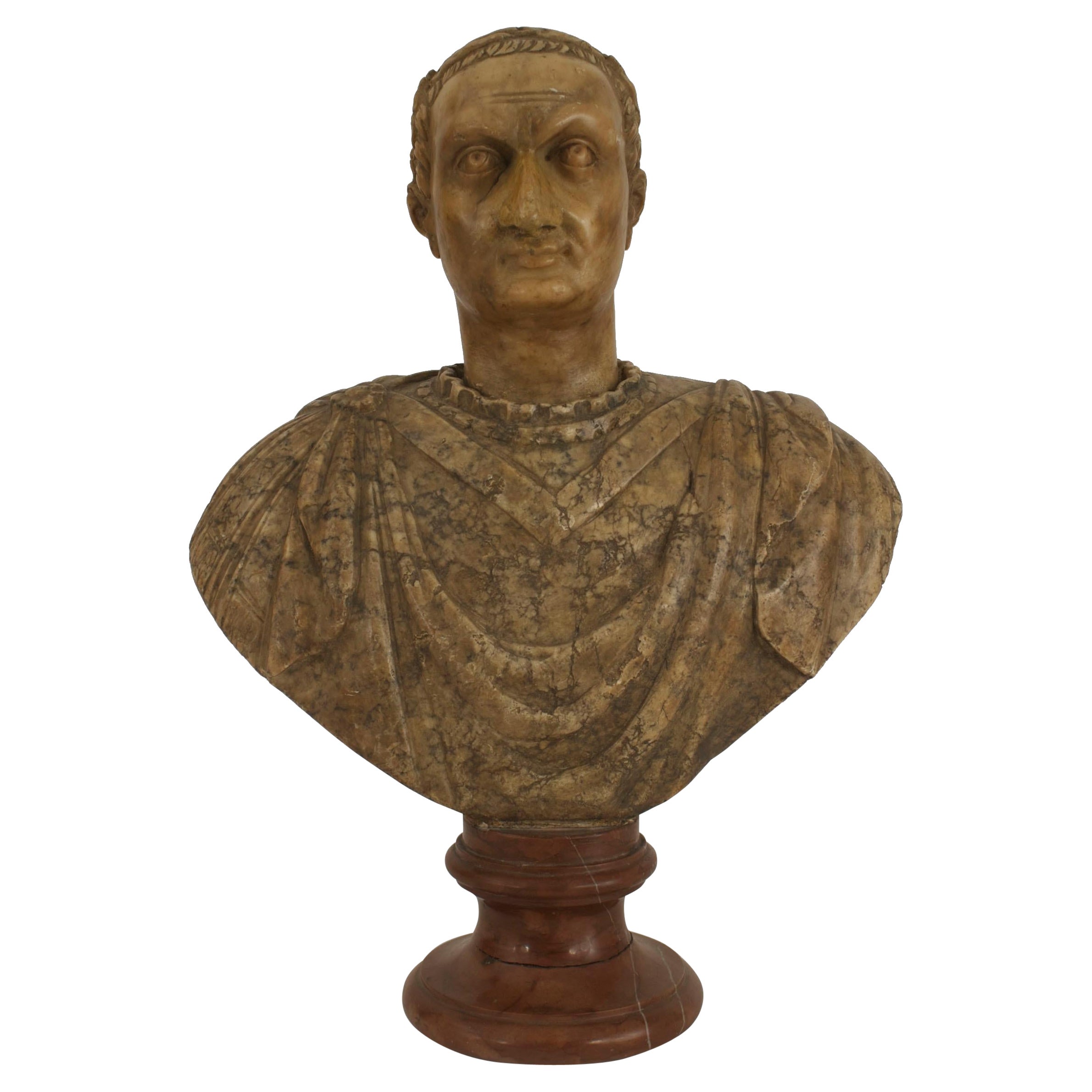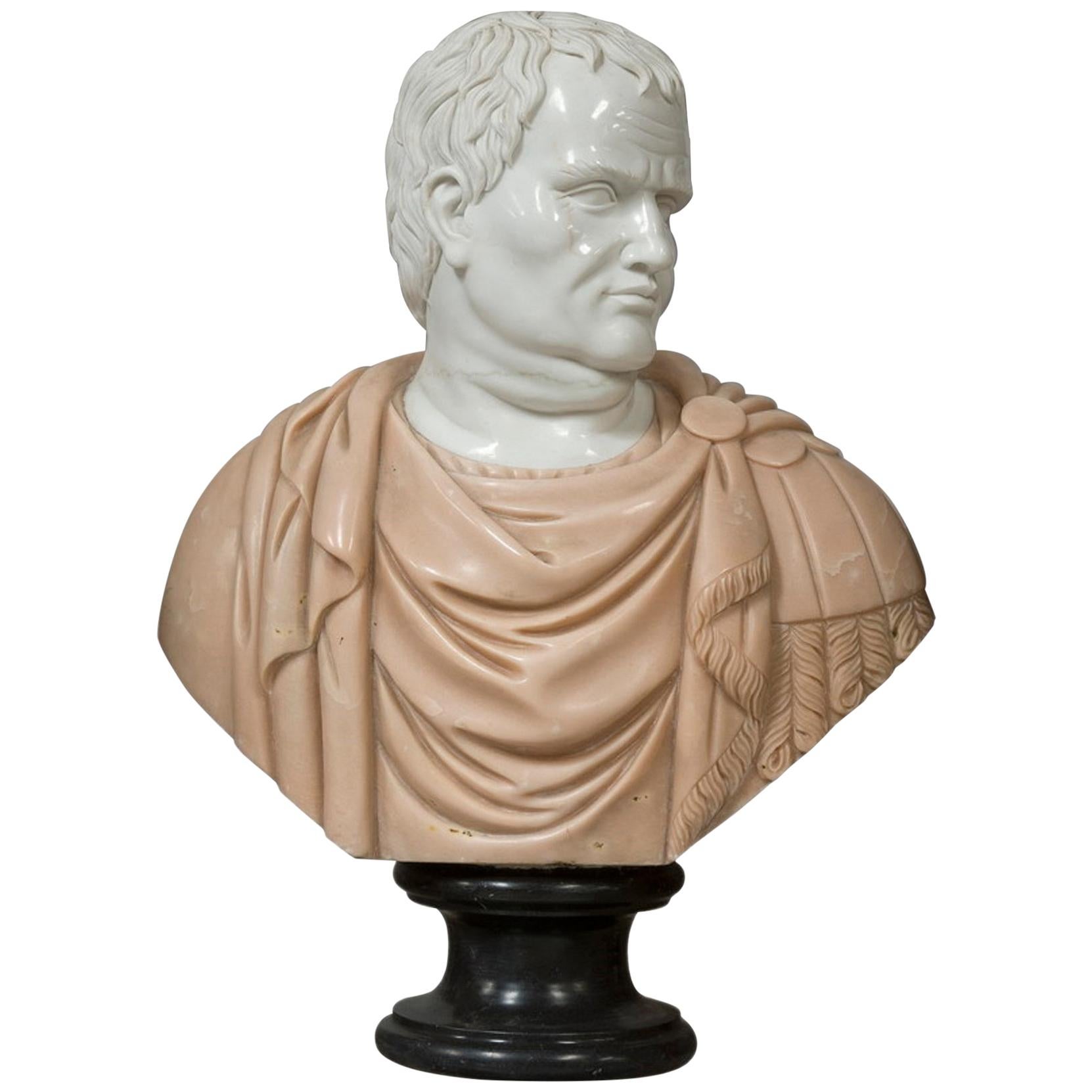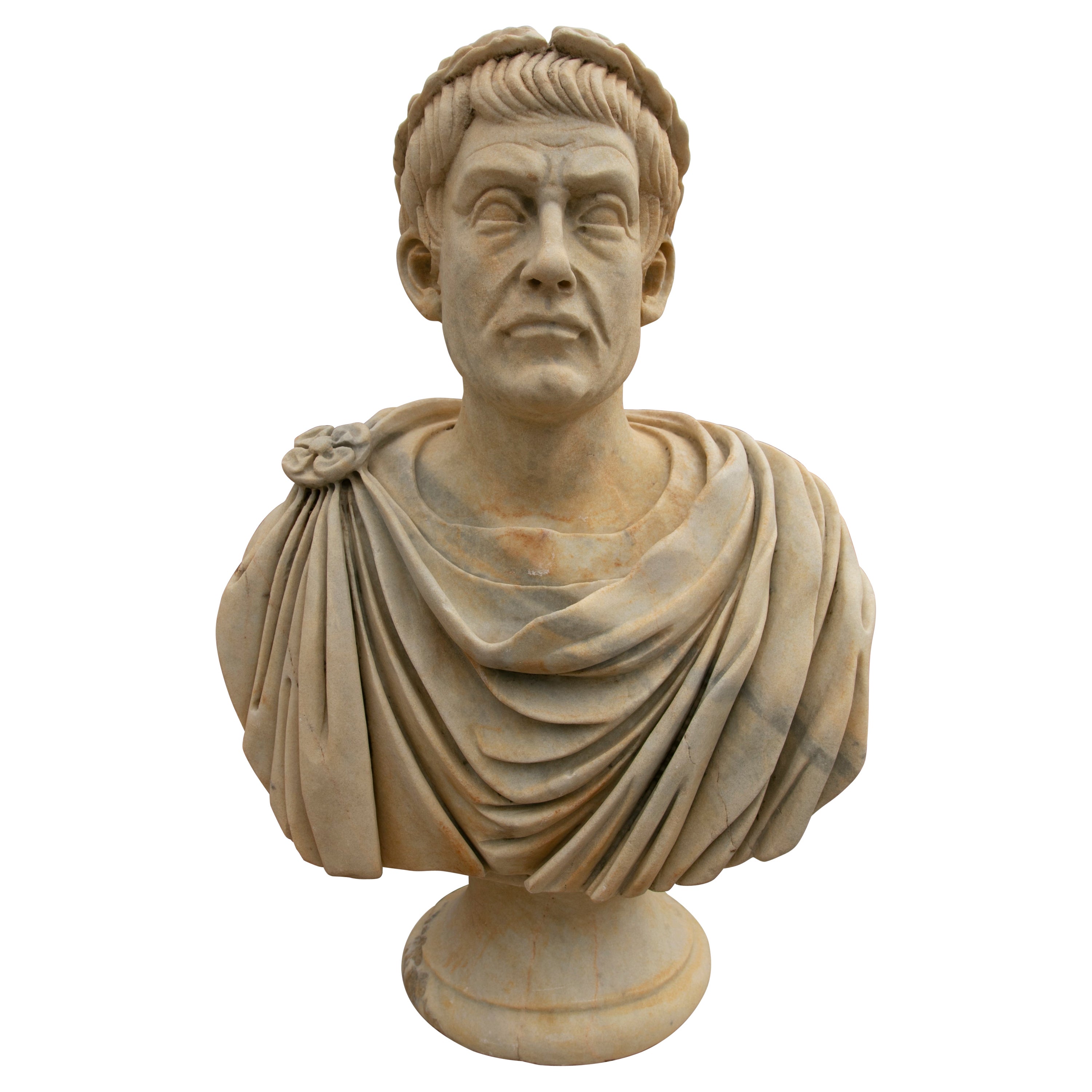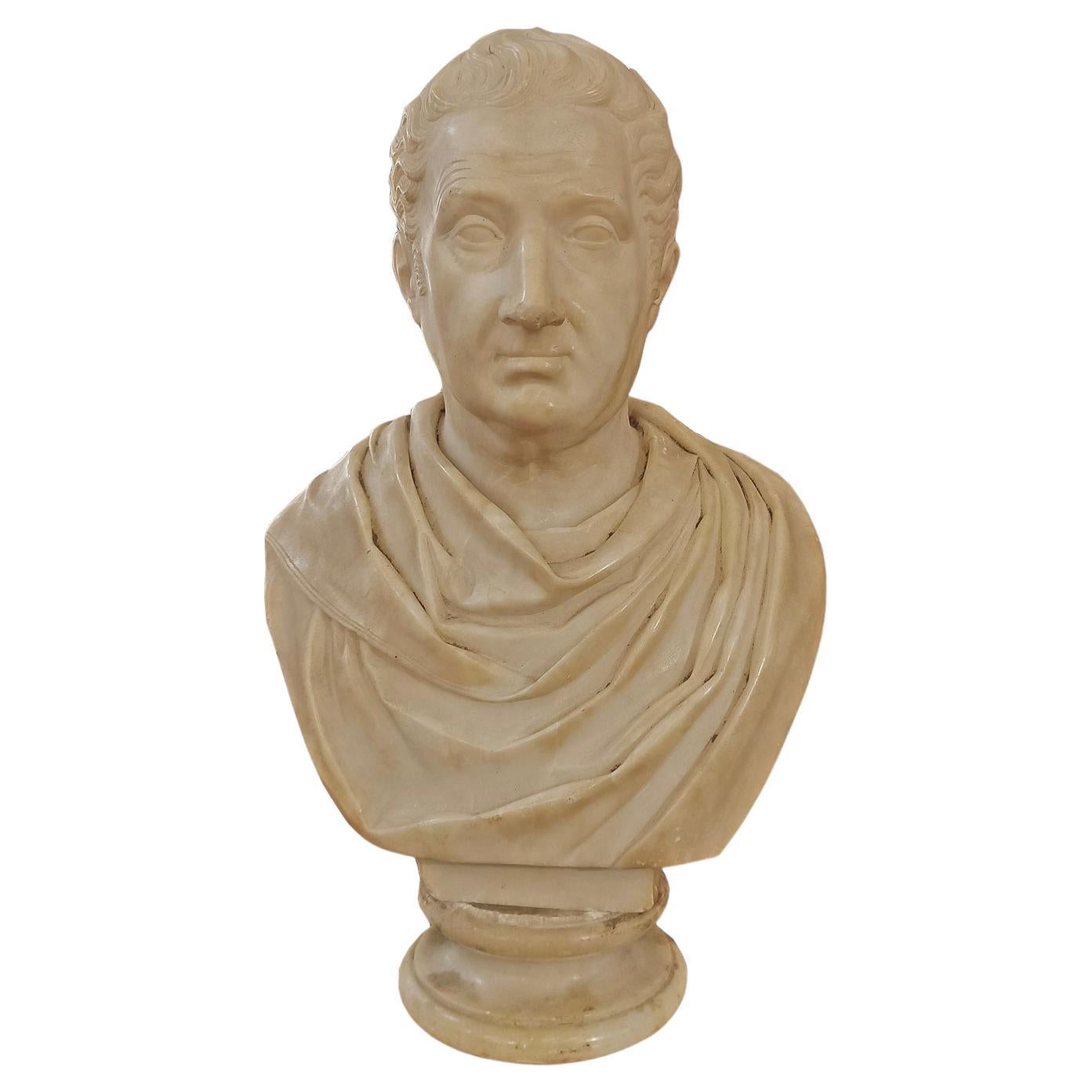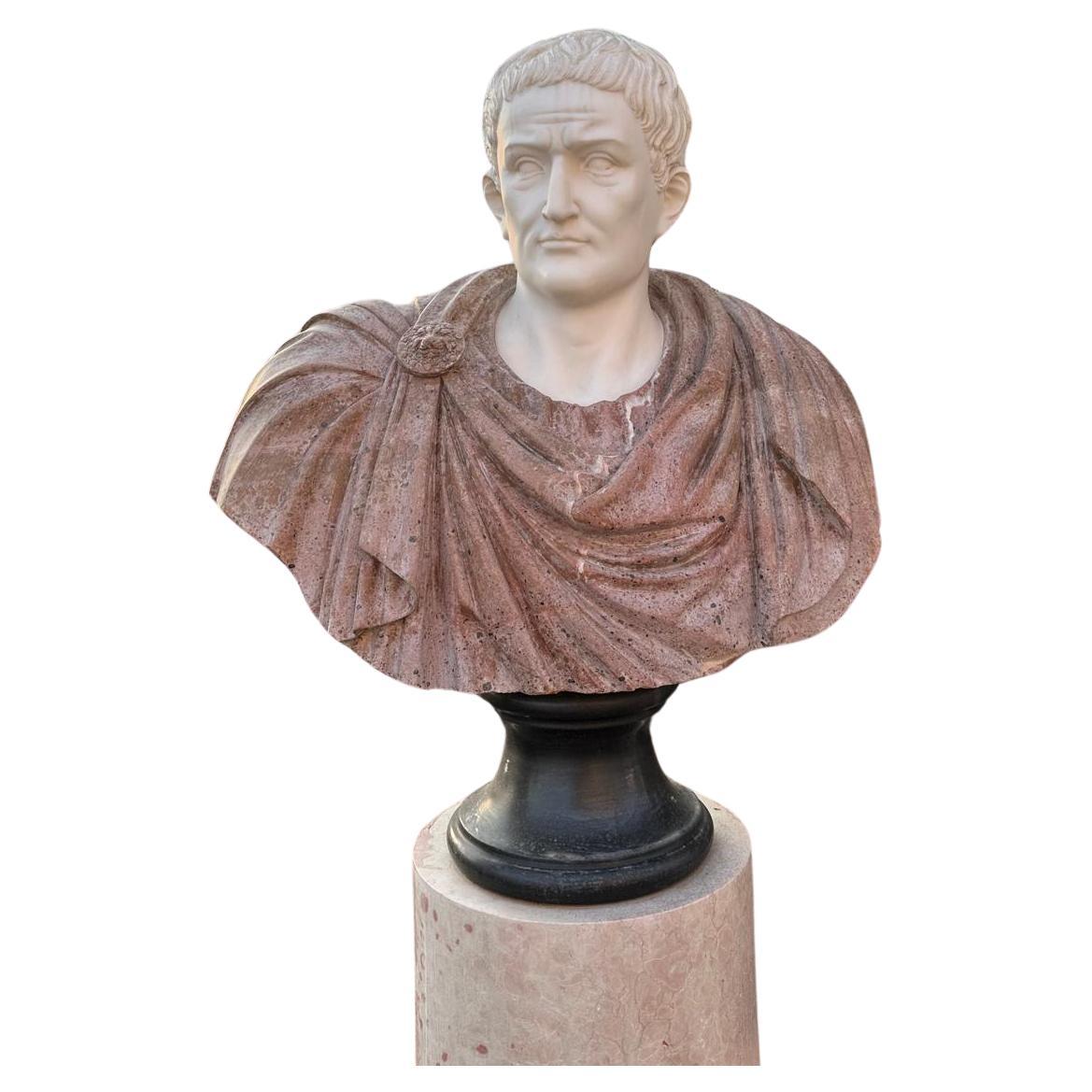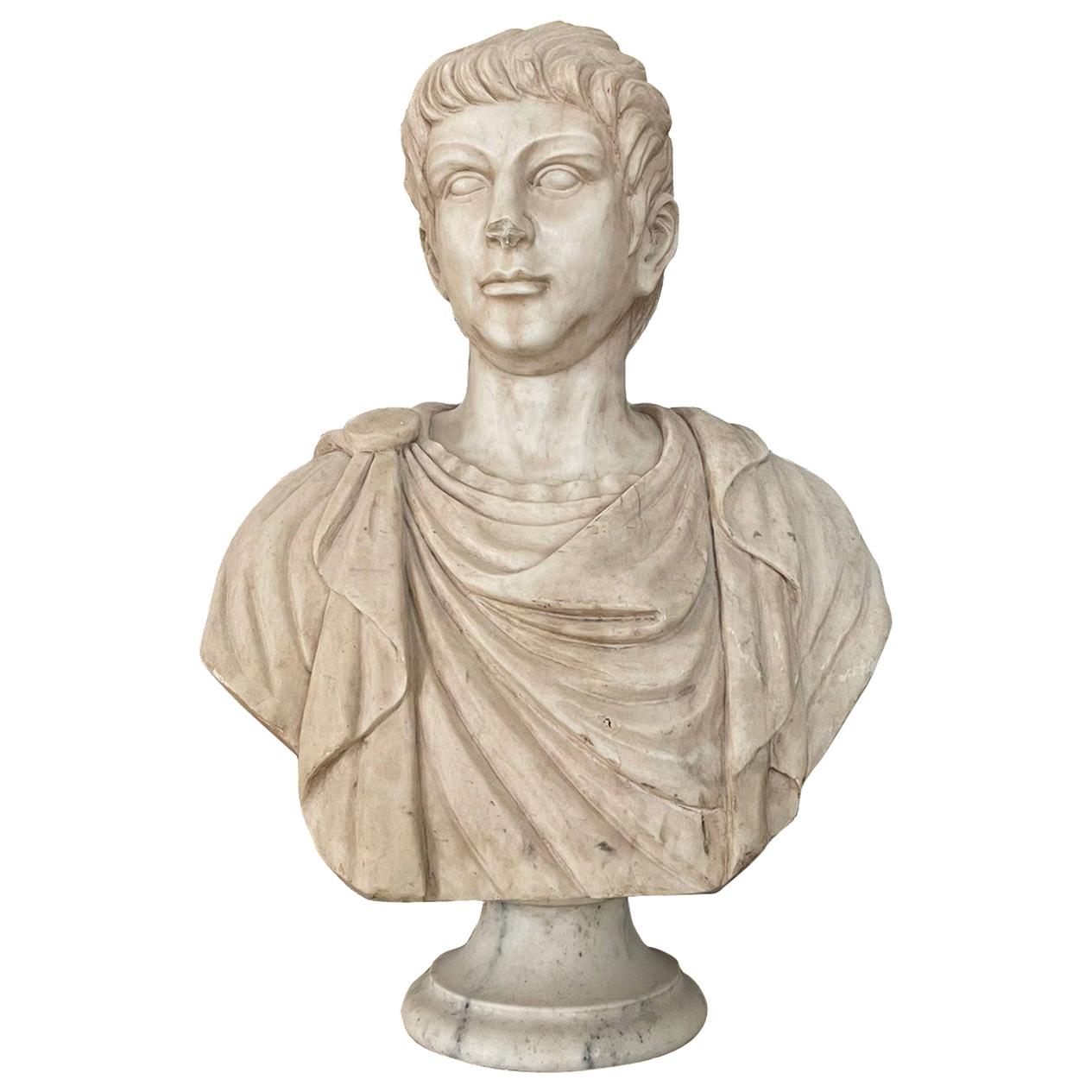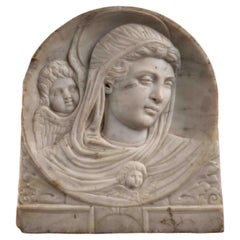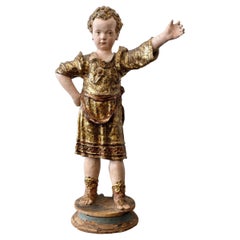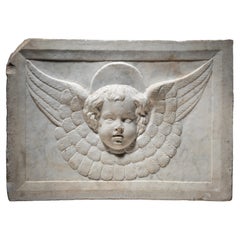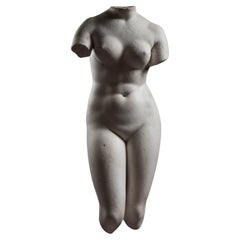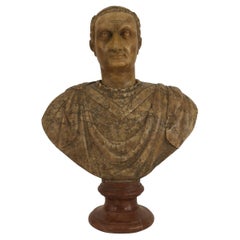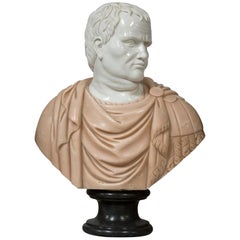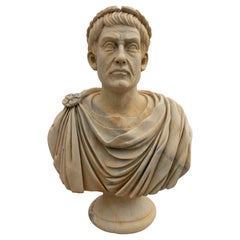Items Similar to Renaissance Marble Portrait - Northern Italy, 17th century
Want more images or videos?
Request additional images or videos from the seller
1 of 11
Renaissance Marble Portrait - Northern Italy, 17th century
$9,567.75
$11,959.6920% Off
£7,058.36
£8,822.9520% Off
€8,000
€10,00020% Off
CA$13,245.04
CA$16,556.3020% Off
A$14,361.50
A$17,951.8820% Off
CHF 7,621.48
CHF 9,526.8520% Off
MX$176,880.14
MX$221,100.1820% Off
NOK 94,463.43
NOK 118,079.2920% Off
SEK 89,151.76
SEK 111,439.7020% Off
DKK 60,908.26
DKK 76,135.3220% Off
About the Item
Renaissance Marble Portrait
Northern Italy, 17th century, inspired by antiquity
Marble
36 x 13 cm (including the marble pedestal)
This Renaissance portrait head of a young man, slightly turned to the left, was designed to be inserted into a bust. The wrinkled forehead, sharp eyebrows, sunken cheeks, and thin lips are all classic signs of Verism. The man's gaze is fixed on a distant object, giving him the appearance of looking far into the future. The non-drilled pupils and lack of incised irises suggest inspiration from the late 1st century B.C., at the close of the Republican Period and the beginning of the Julio-Claudian Dynasty. The artist has sensitively defined the wrinkles, folds of skin, and details of the effigy, creating the illusion of a living presence.
This portrait likely represents an emperor or condottiere from classical antiquity and was probably part of a larger marble bust, « the quintessential Roman portrait format ». During the Renaissance, this format transformed from an idol or cult image into the representation of a living person meant for display on private property. Verist portraits were often attached to idealized torsos with washboard abdominal muscles and chiseled pectorals, portraying the subjects as both strong-minded and able-bodied. Such groups of worthies were featured as decorative schemes in the studioli and architectural projects of Renaissance statesmen. Attesting to the sophistication of their learned patrons, these heads also provided artists the opportunity to explore the contemporary stylistic relevance of classical portraiture.
The deliberately achieved intensity of a living presence is filtered through the tradition of classical sculpture but remains resolutely contemporary. The classical makeup reflects the sculptor’s study of antiquity as well as the client's expectations. Collecting ancient sculptures was an indication of status, and identification with classical ideals was widespread. The Roman custom of setting up busts of ancestors in the atrium was revived, using busts in a classical style.
Thomas Martin states: “In seeking the origins of the classicizing bust in Venice, for example, the most determining factor seems to be the particular fervor manifested in Northern Italy towards the cult of the antique.” Martin convincingly argues the connection between the collecting of antiquities and the production of classicizing busts. The city was a center of an ambitious and sophisticated antiquarian culture, and the Paduan humanists were devoted to the emulation of antiquity.
The choice of marble as a medium symbolizes the durability and timelessness of the subject and reflects the artist's reverence for the classical traditions of Roman sculpture. Among the most notable achievements of the Italian Renaissance in art was the revival of the classical tradition of the independent portrait bust. Overall, this Renaissance marble portrait head serves as a testament to the enduring influence of ancient Roman art on the artists of the Renaissance, showcasing a blend of classical aesthetics and artistic innovation that continues to inspire admiration and awe to this day.
- Dimensions:Height: 14.18 in (36 cm)Width: 5.12 in (13 cm)Depth: 5.12 in (13 cm)
- Style:Renaissance (Of the Period)
- Materials and Techniques:
- Place of Origin:
- Period:
- Date of Manufacture:17th century
- Condition:Repaired: little visible restoration. Refinished. Wear consistent with age and use.
- Seller Location:Bruxelles, BE
- Reference Number:1stDibs: LU6666240615432
About the Seller
5.0
Vetted Professional Seller
Every seller passes strict standards for authenticity and reliability
1stDibs seller since 2022
15 sales on 1stDibs
Typical response time: <1 hour
- ShippingRetrieving quote...Shipping from: Bruxelles, Belgium
- Return Policy
Authenticity Guarantee
In the unlikely event there’s an issue with an item’s authenticity, contact us within 1 year for a full refund. DetailsMoney-Back Guarantee
If your item is not as described, is damaged in transit, or does not arrive, contact us within 7 days for a full refund. Details24-Hour Cancellation
You have a 24-hour grace period in which to reconsider your purchase, with no questions asked.Vetted Professional Sellers
Our world-class sellers must adhere to strict standards for service and quality, maintaining the integrity of our listings.Price-Match Guarantee
If you find that a seller listed the same item for a lower price elsewhere, we’ll match it.Trusted Global Delivery
Our best-in-class carrier network provides specialized shipping options worldwide, including custom delivery.More From This Seller
View AllRenaissance Marble Relief - Emilia Romagna, 1470-80
Located in Bruxelles, BE
Renaissance Marble Relief
Emilia Romagna, Faenza ? 1470-80
H 30,2 x L 33 x P 3,5 cm
The carved marble relief depicts the Virgin accompanied by a winge...
Category
Antique 15th Century and Earlier Italian Renaissance Figurative Sculptures
Materials
Marble
Cercle of Romano Alberti, Page, Around 1530-1540
Located in Bruxelles, BE
Cercle of Romano Alberti, dit Il Nero da Sansepolcro ( San Sepolcro, 1521-1568 )
Page
Mixed media : wood core, papier mâché, stucco, polychrome and gilded
Italy, around 1530-154...
Category
Antique 16th Century Italian Renaissance Figurative Sculptures
Materials
Stucco, Wood, Paper
$12,438 Sale Price
35% Off
Cercle of Jacopo della Pila - Marble relief depicting a winged Cherub
Located in Bruxelles, BE
Cercle of Jacopo della Pila (Lombard, in Naples 1471-1502)
Marble relief depicting a winged Cherub
Naples, second half of15th century
40 x 57 x 12 cm
Exquisitely carved, this relief portrays a winged cherub with cascading hair and delicate features. The cherub's plump, smooth countenance, rounded cheeks, outlined lips, and finely drawn nose emanate a sense of tenderness. The quadrangular module, is adorned with a carved frame. The relief ascends gradually, transitioning from the low relief of the wings to the high relief of the head.
The rectangular frame and the subtly curved form of the artwork suggest that the relief likely adorned the upper part of an arch or a vaulted chapel. The type is that of the perspective room with a coffered ceiling decorated with figures of winged cherubs, which is found in various Neapolitan chapels of the 15th century. Coffered ceilings attest to the recovery of antiquity and the search for luxury in Renaissance architecture, first in Florence, then in Rome and Naples. The majority of the numerous family chapels and tombs built during the late fifteenth century in south of Italy employ the new formal vocabulary of the Florentine Renaissance in a self-confident manner that permitted a broad spectrum of variations.
The escalating admiration for the classical world, coupled with the development of perspective, significantly contributed to the Renaissance endorsement of coffered ceilings. This artistic and constructive device drew inspiration from the intricate marble patterns observed in historical landmarks such as the Arch of Titus, the Temple of Vesta in Tivoli, the Pantheon, and the Basilica of Maxentius. A distilled product of both mathematical and artistic cultures, deeply scrutinizing the ancient world, the coffered ceiling plays a vital role in the perspective construction of space with its regular and directional geometry. The motif of the coffered ceiling decorated with cherubs in relief was introduced in Naples by Francesco Laurana in the plastic decoration of the Arch of Castelnuovo. Laurana's impact on the art scene in the south of Italy was profound. The introduction of the winged cherub into the region's artistic vocabulary bridged the gap between the classical and the contemporary, creating a synthesis that resonated with both aesthetic and spiritual sensibilities. His influence extended beyond the immediate visual appeal, shaping the cultural identity of the Renaissance in southern Italy. Although the plastic decoration of the Arch of Castelnuovo cannot certainly be ascribed to a mature Renaissance style, it was precisely on this occasion that the sculptors who worked there could get to know and export throughout the Italian peninsula that type of "Florentine classicism" which, even in the 15th century Naples, was conditioned by the Burgundian culture imported into the Kingdom by Alfonso of Aragon himself, with artists called from Spain and Northern Europe. The coffered ceiling, with its geometric patterns and Laurana's winged cherubs nestled within, became a symbol of refinement and cultural sophistication. The relief sculptures, carefully integrated into the overall design, transformed the ceiling into a celestial realm, inviting viewers to contemplate the divine while immersed in the grandeur of the Renaissance space.
Similar winged cherubs appears also in the Naples cathedral. Within the renowned Succorpo Chapel, a mesmerizing marble coffered ceiling adorned with cherubs epitomizes the splendor of the Neapolitan Renaissance. The interplay of light and shadow on the textured surface of the marble coffered ceiling introduces an ethereal dimension, providing an immersive visual experience for observers. The geometric precision and the repeated patterns, reminiscent of classical motifs, establish a sense of harmony and balance that has become the hallmark of the Neapolitan interpretation of Florentine Renaissance aesthetics.
Although probably intended to be admired from a distance, this cherub is intricately detailed and exquisitely rendered: the face and hair are elegantly outlined and the feathers are textured through juxtaposed lines. The marble, both figurative and decorative, adheres to the principles of balance and restrained ornamentation typical of the « Florentine Classicism ». Harmonious shapes and gracefully orchestrated curves , rooted in the classical repertoire, converge to evoke a sense of ethereal beauty. The surface displays the masterful use of a chisel to intricately carve the feathers and facial features, creating an almost abstract quality.
This work is a testament to a sculptor of great skill and rich figurative knowledge, seamlessly blending classical firmness in contours with a refined treatment of the marble's surface. The combination of tradition and innovation point to a stylistic idiom from Lombardy, in particular we can find some comparaisons with the works of Jacopo della Pila, sculptor of Lombard origin working in Naples in the second half of the 15th century. He is documented there between 1471 and 1502, and is a protagonist of the Aragon Renaissance in the second half of the Quattrocento, together with the other great Northern sculptor active in the kingdom, Domenico Gagini.
the first commission he received dates back to August 9, 1471, when Jacopo publicly committed to sculpting the funerary monument of Archbishop Nicola Piscicelli to be placed in the Cathedral of Salerno. The last known work is an altar ordered on July 29, 1502, by the noble Jacopo Rocco for the church of San Lorenzo Maggiore in Naples. Between these two chronological extremes (1471-1502), we must place the fervent activity of the artist, who had trained in Rome, perhaps under the guidance of Paolo Romano but also engaged in dialogue with other major artists of the city, especially Isaia da Pisa. He enriched his experience in Naples, initially drawing inspiration from the works of Domenico Gagini and later from the Tuscan masterpieces of Antonio Rossellino and Benedetto da Maiano destined for the church of Santa Maria di Monteoliveto. Jacopo della Pila's artistic personality is thus based on a complex interplay of influences, contributing to the definition of a highly personal style.
Close comparaison can be made between our cherub and the winged angels reliefs...
Category
Antique 15th Century and Earlier Italian Renaissance Figurative Sculptures
Materials
Marble
$22,962 Sale Price
20% Off
Venus Pudica (Medici-type) - 18th century, Italy
Located in Bruxelles, BE
Monumental sculpture representing the Venus Pudica (Medici-type)
18th Century
Italian (Rome)
White marble
Based on a model from Antiquity, the Medici Venus, currently in the Uffizi ...
Category
Antique Early 18th Century Italian Grand Tour Figurative Sculptures
Materials
Marble
Renaissance relief - Italy, probably Rome, 16th century
Located in Bruxelles, BE
Renaissance relief depicting two female figures dressed in a chiton
Italy, probably Rome, 16th century
Marble, wooden frame (provenance label on the back)
28 x 20 x 5 cm
This beau...
Category
Antique 16th Century Italian Renaissance Wall-mounted Sculptures
Materials
Marble
Balsamarium shaped as a Bust of a Black Boy - Roman, 1st – 2nd Century AD
Located in Bruxelles, BE
Balsamarium shaped as a Bust of a Black Boy
Bronze, silver inlaid eyes and lips, Roman, 1st – 2nd Century AD
Provenance:
Private London Collection formed 1965-1975
H 10 cm (4 in...
Category
Antique 15th Century and Earlier Italian Classical Roman Models and Mini...
Materials
Silver, Bronze
You May Also Like
Italian Neo-Classic Style Marble Bust of Roman Emperor
Located in Queens, NY
Italian neo-classic style (19th Cent) light brown marble bust of a Roman emperor mounted on a round plinth.
Category
Antique 19th Century Neoclassical Busts
Materials
Stone, Metal
Marble Sculpture Inspired by Busts Portraits of the Roman Empire
Located in Madrid, ES
In the portrait is where Rome gives his most characteristic contribution of the tradition founded by the Greeks, a contribution that has matured much earlier than in other types of s...
Category
20th Century Unknown Other Busts
Materials
Marble
Spanish Neoclassical Style Hand Carved Aged White Marble Bust of Juiious Caesar
Located in Marbella, ES
Spanish neoclassical style hand carved aged white marble bust of Roman emperor Julius Caesar wearing imperial robes and laurel wreath.
Category
Late 20th Century Spanish Busts
Materials
Marble
LATE 18th CENTURY MARBLE BUST OF ROMAN SENATOR
Located in Firenze, FI
Beautiful white marble bust, finely worked, portraying a Roman senator. The work captures with great precision the physiognomic features of the subject, reflecting the distinctive ch...
Category
Antique Late 18th Century Italian Neoclassical Revival Busts
Materials
Marble
Huge Marble Bust of an Roman Emperor 95 cm
Located in Madrid, ES
Introducing an impressive Italian Marble Bust of an Emperor, exquisitely carved from colorful marbles sourced from Italian quarries. This magnificent piece showcases exceptional craf...
Category
Vintage 1950s Statues
Materials
Marble
Marble Sculpture Bust Of Emperor Julius Caesar After The Antique Grand Tour
Located in Tivoli Terme, Roma
The sculpture realized by a Roman sculptor as from the Roman academy tradition, is carved with white marble.
The sculpture represents the face of a young Julius Caesar, Julius Caesar formally known as Caesar was a Roman general and statesman who played a critical role in the events that led to the demise of the Roman Republic...
Category
20th Century Italian Classical Roman Busts
Materials
Marble
$8,419 Sale Price
20% Off
More Ways To Browse
17th Century Italian Furniture
Italian Renaissance Art
Antique Atrium
Angel Kneeling
Antique Costa Rica
Antique German Bisque
Antique Gold Pan
Art Deco Goddess
Art Deco Resin Sculpture
Black Egypt Sculpture
Bronze French Soldier
Bronze Sculpture Bacchus
Clesinger Bronze
Cornucopia Sculpture
Cracked Egg
David Gil For Bennington
Europa And Bull
Female Brass Sculpture
